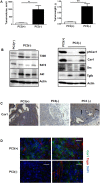Progression-related loss of stromal Caveolin 1 levels fosters the growth of human PC3 xenografts and mediates radiation resistance
- PMID: 28112237
- PMCID: PMC5255553
- DOI: 10.1038/srep41138
Progression-related loss of stromal Caveolin 1 levels fosters the growth of human PC3 xenografts and mediates radiation resistance
Abstract
Despite good treatment results in localized prostate tumors, advanced disease stages usually have a pronounced resistance to chemotherapy and radiotherapy. The membrane protein caveolin-1 (Cav1) functions here as an important oncogene. Therefore we examined the impact of stromal Cav1 expression for tumor growth and sensitivity to ionizing radiation (IR). Silencing of Cav1 expression in PC3 cells resulted in increased tumor growth and a reduced growth delay after IR when compared to tumors generated by Cav1-expressing PC3 cells. The increased radiation resistance was associated with increasing amounts of reactive tumor stroma and a Cav1 re-expression in the malignant epithelial cells. Mimicking the human situation these results were confirmed using co-implantation of Cav1-silenced PC3 cells with Cav1-silenced or Cav1-expressing fibroblasts. Immunohistochemically analysis of irradiated tumors as well as human prostate tissue specimen confirmed that alterations in stromal-epithelial Cav1 expressions were accompanied by a more reactive Cav1-reduced tumor stroma after radiation and within advanced prostate cancer tissues which potentially mediates the resistance to radiation treatment. Conclusively, the radiation response of human prostate tumors is critically regulated by Cav1 expression in stromal fibroblasts. Loss of stromal Cav1 expression in advanced tumor stages may thus contribute to resistance of these tumors to radiotherapy.
Figures








Similar articles
-
Progression-Related Loss of Stromal Caveolin 1 Levels Mediates Radiation Resistance in Prostate Carcinoma via the Apoptosis Inhibitor TRIAP1.J Clin Med. 2019 Mar 12;8(3):348. doi: 10.3390/jcm8030348. J Clin Med. 2019. PMID: 30871022 Free PMC article.
-
Caveolin-1 regulates the ASMase/ceramide-mediated radiation response of endothelial cells in the context of tumor-stroma interactions.Cell Death Dis. 2020 Apr 9;11(4):228. doi: 10.1038/s41419-020-2418-z. Cell Death Dis. 2020. PMID: 32273493 Free PMC article.
-
Endothelial Caveolin-1 regulates the radiation response of epithelial prostate tumors.Oncogenesis. 2015 May 18;4(5):e148. doi: 10.1038/oncsis.2015.9. Oncogenesis. 2015. PMID: 25985209 Free PMC article.
-
Caveolin-1, cancer and therapy resistance.Int J Cancer. 2018 Nov 1;143(9):2092-2104. doi: 10.1002/ijc.31369. Epub 2018 Mar 30. Int J Cancer. 2018. PMID: 29524224 Review.
-
Caveolin-1, breast cancer and ionizing radiation.Cancer Genomics Proteomics. 2015 May-Jun;12(3):143-52. Cancer Genomics Proteomics. 2015. PMID: 25977173 Review.
Cited by
-
Development of a prediction model for radiotherapy response among patients with head and neck squamous cell carcinoma based on the tumor immune microenvironment and hypoxia signature.Cancer Med. 2022 Dec;11(23):4673-4687. doi: 10.1002/cam4.4791. Epub 2022 May 3. Cancer Med. 2022. PMID: 35505641 Free PMC article.
-
Progression-Related Loss of Stromal Caveolin 1 Levels Mediates Radiation Resistance in Prostate Carcinoma via the Apoptosis Inhibitor TRIAP1.J Clin Med. 2019 Mar 12;8(3):348. doi: 10.3390/jcm8030348. J Clin Med. 2019. PMID: 30871022 Free PMC article.
-
Molecular pathogenesis, mechanism and therapy of Cav1 in prostate cancer.Discov Oncol. 2023 Nov 1;14(1):196. doi: 10.1007/s12672-023-00813-0. Discov Oncol. 2023. PMID: 37910338 Free PMC article. Review.
-
Caveolin-1 regulates the ASMase/ceramide-mediated radiation response of endothelial cells in the context of tumor-stroma interactions.Cell Death Dis. 2020 Apr 9;11(4):228. doi: 10.1038/s41419-020-2418-z. Cell Death Dis. 2020. PMID: 32273493 Free PMC article.
-
The Biomarker Potential of Caveolin-1 in Penile Cancer.Front Oncol. 2021 Mar 31;11:606122. doi: 10.3389/fonc.2021.606122. eCollection 2021. Front Oncol. 2021. PMID: 33868995 Free PMC article.
References
Publication types
MeSH terms
Substances
LinkOut - more resources
Full Text Sources
Other Literature Sources
Medical
Research Materials

